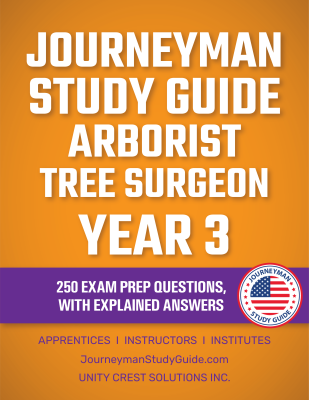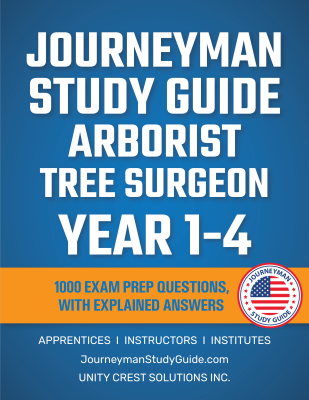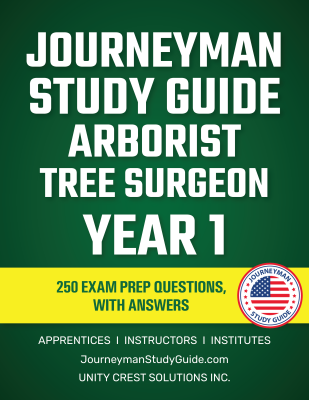Questions, Answers, & Explanations
Get clear explanations behind every answer, perfect for deeper learning and more thorough exam preparation.
Site Updates in Progress: Things might look different as we work on enhancing your experience.
What is an Arborist/Tree Surgeon?
An Arborist, also known as a Tree Surgeon, is a skilled professional responsible for the care and maintenance of trees, shrubs, and other woody plants in urban, residential, and commercial environments. Arborists ensure trees remain healthy and safe through pruning, disease management, and controlled removals when necessary. This trade requires expertise in tree biology, proper cutting techniques, and safety protocols when working at heights.
Arborists commonly work in municipal parks, private landscaping firms, and commercial tree care companies, using chainsaws, climbing gear, and aerial lifts to manage tree health. The profession is physically demanding and requires knowledge of tree structure, disease prevention, and equipment operation.
Key Responsibilities
Arborists perform a variety of tasks that require technical skill, physical endurance, and a deep understanding of tree care. Their primary duties include:
Skills and Traits for Success
Successful arborists possess a combination of technical knowledge, physical endurance, and attention to safety. Key traits include:
Industries Where Arborists Thrive
Arborists work in a variety of industries, including:
Why Choose This Career?
Becoming an arborist offers job stability, outdoor work, and opportunities for career advancement. Benefits include:
Ready to Start Your Career as an Arborist?
Prepare for success with our study guides, Q&A products, and interactive online tests designed specifically for aspiring arborists. Build your knowledge, master key concepts, and get ready for certification with our expertly crafted resources.
What to Expect on the Arborist Certification Exam
The Certified Arborist Exam ensures that professionals meet U.S. industry standards for tree care, climbing safety, disease management, and pruning techniques. Many American employers, tree care companies, and municipalities require certification as proof of expertise in tree health management and workplace safety. Becoming certified demonstrates your proficiency in tree biology, rigging operations, and OSHA compliance.
Exam Format
The certification exam evaluates both theoretical knowledge and hands-on practical skills. Here’s what you can expect:
Key Topics Covered
The exam is divided into sections to assess critical tree care and safety knowledge.
1. Safety and Workplace Practices
2. Tree Biology and Identification
3. Climbing and Rigging Techniques
4. Pruning, Cutting, and Removal Techniques
5. Mathematical Applications
Passing Requirements
Most certifying bodies, such as the International Society of Arboriculture (ISA) and Tree Care Industry Association (TCIA), require a minimum score of 70% or higher to pass the written exam. Some programs also require a practical skills assessment where candidates demonstrate safe climbing techniques, pruning methods, and emergency response preparedness.
Tips for Preparing Effectively
Ready to Pass Your Exam?
Prepare for certification with our expertly crafted study guides, detailed Q&A explanations, and interactive online tests tailored specifically for arborists.
What Types of Questions Are on the Arborist Certification Exam?
The Certified Arborist Exam assesses your knowledge of tree care, safety standards, climbing techniques, disease management, and industry regulations. The test includes a variety of question formats designed to evaluate your ability to diagnose tree health, use rigging systems safely, and apply proper pruning methods. Understanding these question types will help you prepare effectively and demonstrate your expertise with confidence.
Common Question Formats
1. Multiple-Choice Questions
These questions assess your theoretical knowledge of tree biology, rigging equipment, and pruning best practices. Each question presents four answer choices, with one correct response.
2. Scenario-Based Questions
Real-world arboriculture situations challenge you to apply problem-solving skills. You may be asked to identify tree health issues, determine the safest method of branch removal, or respond to an emergency on the job.
3. Calculation Questions (Math-Based)
Math-based questions test your ability to calculate rigging loads, estimate tree heights, and determine safe cutting angles. These require a solid understanding of geometry, weight distribution, and force dynamics.
4. Equipment and Tree Identification
These questions require you to recognize tree species, pruning tools, and safety gear. You may need to match tools to their functions or diagnose tree diseases based on visual descriptions.
Sample Questions
Below are examples of the types of questions you might encounter on the exam:
1. Safety and Workplace Practices
Question: "Which of the following is a required component of an OSHA-approved fall protection system for arborists?"
Answer: B) A full-body harness and double lanyard system
2. Tree Biology and Disease Management
Question: "A tree shows signs of yellowing leaves, bark splitting, and a fungal presence at the base. What is the most likely cause?"
Answer: C) Root Rot
3. Math for Arborists
Question: "A tree measures 50 feet in height and has a branch extending 20 feet outward at a 45-degree angle. If you need to secure the branch with rigging before cutting, what is the estimated weight load you need to consider?"
Answer: B) 450 lbs
4. Equipment and Tool Identification
Question: "Which tool is best suited for making precise, clean cuts on small to medium branches?"
Answer: C) Hand pruners
Tips for Answering Exam Questions
Practice Questions for Better Preparation
Engaging with practice exams is one of the most effective ways to improve performance. Benefits include:
Our Q&A with Explanations helps you understand why answers are correct, while our Online Tests simulate real testing conditions with live scoring and feedback.
Want More Practice?
Access hundreds of practice questions, detailed explanations, and interactive tests tailored for aspiring arborists. Improve your confidence and ensure success on exam day.
What Is It Like to Work as an Arborist?
The daily life of an Arborist/Tree Surgeon is fast-paced, physically demanding, and rewarding. Arborists spend much of their day climbing trees, pruning branches, diagnosing tree health issues, and ensuring public safety. Whether working for a tree care company, municipal parks department, or private property owner, arborists play a crucial role in preserving urban forests and maintaining safe outdoor spaces.
Morning: Preparing for the Job
A typical day begins early, around 6:30 or 7:00 AM, with planning and safety briefings:
Midday: Climbing, Pruning, and Tree Removal
The majority of the workday involves physically intensive tree climbing, cutting, and maintenance work.
Afternoon: Site Cleanup & Reporting
Challenges and Rewards
Ready to Start Your Career as an Arborist?
Prepare with our study guides, Q&A products, and interactive online tests designed to help you master certification exams and excel in the field.
What Are the Long-Term Benefits of a Career as an Arborist?
A career as an Arborist/Tree Surgeon offers long-term job stability, competitive wages, and advancement opportunities in urban forestry, commercial tree care, and environmental conservation. Whether working for a municipal park service, private landscaping firm, or tree removal company, arborists enjoy rewarding work that directly impacts public safety and environmental sustainability.
Earning Potential in Arboriculture
Salaries in the tree care industry vary based on experience, certifications, and location:
1. Entry-Level (Ground Worker, Tree Climber, or Arborist Apprentice)
2. Certified Journeyperson Arborist (Tree Surgeon, Crew Leader, or Utility Line Arborist)
3. Advanced-Level (Tree Care Foreman, Urban Forester, or Business Owner)
Career Growth Opportunities
1. Specialization in Advanced Tree Care
2. Supervisory and Management Roles
3. Union Membership Benefits
4. Business Ownership and Consulting
The Importance of Certification
Why Choose a Career in Arboriculture?
Ready to Advance Your Career in Arboriculture?
Prepare for certification and career success with our study guides, Q&A materials, and interactive online tests tailored for arborists.
How Much Can You Earn as an Arborist?
Salaries for arborists in the United States vary based on experience, certifications, location, and industry demand. Whether you are an entry-level climber, a certified tree specialist, or a business owner, arboriculture offers competitive pay and long-term financial security.
General Wage Ranges
1. Entry-Level (Ground Crew, Tree Climber, or Apprentice Arborist)
2. Certified Journeyperson Arborist (Tree Surgeon, Utility Arborist, or Crew Leader)
3. Advanced-Level (Tree Care Foreman, Urban Forester, or Business Owner)
Regional Salary Differences
1. Northeast (New York, Massachusetts, Pennsylvania)
2. South (Texas, Florida, Georgia)
3. West Coast (California, Oregon, Washington)
Factors That Impact Wages
Want to Boost Your Earning Potential?
Advance your career with our study guides, Q&A products, and interactive online tests to enhance your skills and increase your earning power.
What Tools and Resources Do Arborists Need to Succeed?
Arborists rely on specialized tools, safety gear, and educational resources to perform their work efficiently and safely. Whether climbing trees, operating cutting equipment, or diagnosing tree health, the right tools and knowledge are essential for success.
Essential Tools for Arborists
1. Climbing & Rigging Equipment
2. Cutting & Pruning Tools
3. Safety Gear
Recommended Learning Resources
1. Industry Certifications and Training Programs
2. Trade Associations and Unions
Why the Right Tools Matter
Investing in high-quality equipment and continued education improves efficiency, safety, and long-term career growth. The best arborists stay ahead by using advanced tools and expanding their knowledge through industry-recognized training.
Looking for the Best Study Materials?
Prepare for certification and career success with our study guides, Q&A products, and interactive online tests designed for arborists.
Where Can You Learn Arboriculture?
Arboriculture education programs in the U.S. provide hands-on training and technical instruction to prepare individuals for careers in tree care, urban forestry, and commercial arborist operations. Whether through apprenticeships, vocational schools, or university programs, students gain the skills needed to manage trees safely and effectively.
Types of Arborist Education Programs
1. Apprenticeship and On-the-Job Training
2. Technical and Vocational Schools
3. University Arboriculture Programs
4. Online and Continuing Education Programs
What to Expect in an Arborist Training Program
1. Core Topics Covered
2. Hands-On Training
3. Certification Preparation
How to Choose the Right Program
Why Education Matters in Arboriculture
Investing in proper training enhances job security, career growth, and earning potential. Education prepares arborists to handle hazardous tree removals, urban forestry management, and tree disease treatments.
Ready to Start Your Arborist Career?
Get started with our study guides, certification resources, and interactive practice exams to become a top arborist.
Why Join a Union or Connect with Employers?
Unions and reputable employers provide arborists with job security, competitive wages, and career advancement opportunities. Union membership offers specialized training, benefits, and worker representation, while working with established employers ensures steady employment and professional growth. Leveraging these connections is essential for success in the U.S. tree care industry.
Benefits of Joining a Union
1. Higher Wages and Benefits
2. Job Security
3. Advanced Training
4. Worker Representation
Top Unions for Arborists
1. International Association of Machinists and Aerospace Workers (IAM) – Tree Care Division
2. Laborers' International Union of North America (LIUNA)
Connecting with Employers
1. Types of Employers
2. What Employers Look For
3. How to Stand Out
Tips for Finding Work Through Unions and Employers
Why Unions and Employers Matter
Unions and trusted employers provide stable jobs, valuable training, and career growth. These connections help arborists build a secure future in the industry.
Ready to Connect with the Best Opportunities?
Explore our study guides, union resources, and employer connections to advance your career in arboriculture.
How to Stay Ahead in the Arboriculture Industry
The tree care industry is evolving with advancements in climbing technology, urban forestry strategies, and sustainability practices. Staying competitive as an arborist requires continuous learning, networking, and adapting to emerging industry trends.
Emerging Trends in Arboriculture
1. Advanced Climbing & Rigging Technology
2. Urban Forestry & Sustainability Initiatives
3. Tree Health & Disease Management
Best Practices for Professional Growth
1. Continuing Education & Certifications
2. Networking & Industry Connections
3. Building a Professional Portfolio
4. Adapting to Market Demands
Challenges and Opportunities in Arboriculture
1. Labor Shortages & Skilled Workforce Demand
2. Safety Regulations & Compliance
3. Climate Change & Environmental Impacts
Sustainability in Practice
1. Energy-Efficient Tree Care Practices
2. Urban Greening & Reforestation
Why Staying Ahead Matters
The arboriculture industry is constantly evolving. Staying informed, upgrading skills, and embracing new technologies keep arborists competitive and valuable in the workforce.
Stay Informed, Stay Competitive
Prepare for success with our specialized study guides, certification materials, and insider resources for arborists.
Get clear explanations behind every answer, perfect for deeper learning and more thorough exam preparation.
Quick and easy practice to test your knowledge anytime, anywhere—ideal for simple, on-the-go preparation.










